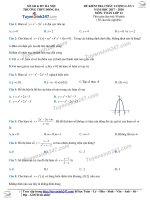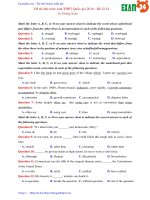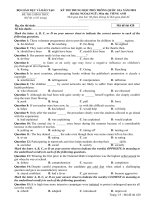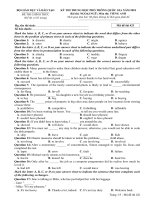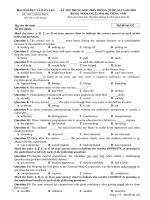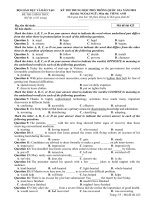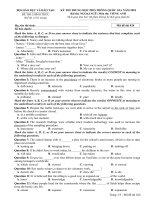Cs224W 2018 42
Bạn đang xem bản rút gọn của tài liệu. Xem và tải ngay bản đầy đủ của tài liệu tại đây (6.16 MB, 11 trang )
Final report for CS224W Analysis of Networks.
EFFICIENT
WITH
PROJECT
TRAFFIC
GRAPH
DETAILS
FORECASTING
EMBEDDING
ARE AVAILABLE
AT HTTPS://GITHUB.COM/SYIN3/CS224W-TRAFFIC.
Jiahui Wang, Zhecheng Wang & Shuyi Yin
CS224W Analysis of Networks, Stanford University, Autumn 2018-2019
{jiahuiw, zhecheng, syin3}@stanford.edu
ABSTRACT
Traffic forecasting is critical for the planning and monitoring of modern urban
systems. Traditional approaches rely on queuing theory, flow theory and simulation techniques; more recent data-driven methods fit time-series and latent space
models. However, they all have limitations, largely due to unrealistic stationary
assumptions, cumbersome parameter calibration, and failure to incorporate spatial and temporal aspects simultaneously. Therefore, any new promising method
must address two challenges: (1) an efficient representation of the complex spatial dependency on road/ sensor networks; (2) non-linear temporal dynamics and
long-term forecasting. In this project, we propose to model spatial dependency
of the directed transportation network with graph embedding techniques, and to
model the temporal dependency with RNN-based time series model. More specifically, our refined model captures both spatial and temporal information effectively
and computational-efficiently, and achieves comparable accuracy with the stateof-the-art models in traffic forecasting.
1
INTRODUCTION
Transportation plays an important role in our daily life. With the increasing amount of vehicles in
the urban area and the development of the autonomous vehicles operations, the need for long-term
traffic forecasting grows rapidly. Accurate, efficient, and robust traffic forecasting model is essential
for intelligent transportation systems (ITSs). Traditional methods for traffic forecasting are built on
queuing theory and mathematical flow theory (Bellman, 1961; Drew, 1968), but they suffer from
the curse of dimensionality. Data-driven methods emerged in recent years which apply time-series
analysis and other statistic models, such as latent space models (Deng et al., 2016; Yu et al., 2016),
while they fail to capture non-linear temporal dynamics of traffic flow.
Recently, machine learning, especially deep learning and neural networks have shown their power in
many fields, and so as in traffic forecasting. These algorithms provide a new way to characterize the
spatio-temporal dependencies in the long-term traffic forecasting (Li et al. (2018); Yu et al. (2018);
Cheng et al. (2017)). With these methods, people can predict the traffic information such as speeds
and volumes during a long period with acceptable accuracy. However, their models rely on complex
architectures with large amount of parameters to capture both spatial and temporal dependencies
and make the training and testing relatively slow, which hampers their application in real-world
large-scale transportation network.
In this paper, we are going to explore the algorithms with data-driven approach to efficiently predict
the future traffic speeds and volumes based on historical data. We seek to improve the previous
models by increasing computation efficiency (Li et al. (2018); Yu et al. (2018); Cheng et al. (2017))
and balancing with accuracy. More specifically, we employ state-of-art graph embedding techniques,
such as Node2Vec
(Grover & Leskovec (2016)) and SDNE
(Wang et al. (2016)), to capture spatial
features of the network in advance, which have never been used for traffic flow forecasting before.
Final report for CS224W Analysis of Networks.
Incorporating the pre-calculated spatial features into the time-series model such as Gated Recurrent
Unit (GRU), we expect our model to gain competing accuracy and better computing efficiency.
2
RELATED
WORK
One of the state-of-the-art modeling of traffic flow is introduced by Li et al. (2018). In their paper,
Li et al. (2018) applied a Diffusion Convolutional Recurrent Neural Network (DCRNN) to capture
both spatial and temporal dependencies. Their model, DCRNN, model the traffic flow as a diffusion process on a directed graph. The highlight of this paper is relating traffic flow to a diffusion
process, which explicitly captures the stochastic nature of traffic dynamics. Despite the state-ofthe-art accuracy of the work, the computational efficiency is poor due to the large model structures
incorporating both Recurrent Neural Network (RNN) and Diffusion-Convolutional Neural Network
(DCNN). Yu et al. (2018) introduces an efficient way to predict the traffic flow by using purely
convolutional structure, which provides a way for processing large-scale networks. To encode the
temporal dynamic behaviors of traffic flows, the paper applies convolutional operations on time series. However, this method can only be applied to undirected graphs for traffic forcasting. In reality,
the traffic network is always two-way and may have different behaviors for in and out flows.
The papers we discuss above using sensors as nodes and sensor distances to derive edge weights.
DeepTransport model (Cheng et al. (2017)) introduces another way, which forecasts the future traffic congestion level of a node by explicitly integrating the features from its upstream nodes and
downstream nodes. However, beyond the scope of certain order, nodes are assumed to have no effect anymore. Therefore, the spatial features of the graph cannot be captured globally, which can
potentially reduce the performance.
Graph embedding techniques can capture and encode spatial features of a graph (Belkin & Niyogi
(2002), Shaw & Jebara (2009), Perozzi et al. (2014), Grover & Leskovec (2016), Bruna et al. (2013),
Defferrard et al. (2016), Wang et al. (2016), Goyal & Ferrara (2018)). They can be divided into three
categories: Factorization methods such as Laplacian eigenmaps (Belkin & Niyogi (2002)), RandomWalk-based methods such as DeepWalk (Grover & Leskovec (2016)) and Node2Vec (Grover &
Leskovec (2016)), and deep-learning-based methods such as Graph Convolutional Network (Bruna
et al. (2013), Defferrard et al. (2016)) and Structural Deep Network Embedding (SDNE) (Wang
et al. (2016)). In general, deep-learning-based methods show stronger capability in capturing the
inherent non-linear dynamics of the graph, and yields better representations of the networks (Goyal
& Ferrara (2018)).
3.
3.1
METHODS
PROBLEM
STATEMENT
We model a transportation sensor network as a graph G(V, E,W), where V is the collection of
all nodes, F is the collection of all edges, and W is the collection of edge weights. Each node
corresponds to a sensor which measures several features at that location such as traffic speed and
volume, and we use ot to represent the traffic feature measurements of sensor (node) ¿ at time f.
Features of all nodes can be represented as X t © RNP where P is the number of features for each
node. Each edge represents the adjacency and relationship (up/downstream) between two nodes and
the its weight characterize the road distance. Here we use the same weight construction scheme as
in Li et al. (2018), which is called Thresholded Gaussian kernel (Shuman
et al., 2013).
For each
entry in the graph adjacency matrix A, the weight of the edge from node 1; to node v;, denoted as
Ajj, is defined as:
dist(v;,v;)?
Ai;
=
te
4:
exp(———z
—)
#fdist(0,0;)
0
otherwise
ơ
.
Final report for CS224W Analysis of Networks.
Where dist(v;, v;) is the road network distance, rather than the cross-fly distance, from node v;
to node v;. o is the standard deviation of distances and k is the threshold. Based on the mea-
surement of features (i.e. traffic speed and volume) at every nodes for S time steps in the past,
[X:—s+1, Xt—s 42, ---Xz], our task is to develop a model to predict [X441, Xt+42, ...X++7] with the
time horizon T in the future. The graph G is also taken as input.
3.2
SPATIAL FEATURE
CAPTURING
Previous works (Li et al. (2018), Yu et al. (2016)) utilized graph convolution network-based models
to characterize the spatial dependency. Their methods suffer from relatively low computation efficiency, which is a general drawback of models based on graph convolution network (GCN), since
the amount of parameters to train in the GCN is huge. In this work, we aim to apply graph embedding to capture the spatial feature of the graph in advance, and then use it as a pre-calculated input in
the time-series traffic prediction model. Such change separates the spatial and temporal dependency
modeling and thus reduces the size and computation time of the time series prediction model, which
enables efficient and scalable traffic forecasting. As far as we know, such separated spatial-temporal
modeling with graph embedding has never been applied in traffic forecasting problems before.
Generally speaking, graph embedding, also named as node embedding within the scope of this
paper, is to map each node into a vector to encode the spatial features of the graph. In this work,
we use Node2Vec (Grover & Leskovec (2016)) and Structural Deep Network Embedding (SDNE)
(Wang et al. (2016)), and compare them with Diffusion Convolutional Recurrent Neural Network
(DCRNN) (Li et al. (2018)) which used graph convolution network as a graph embedding method.
3.2.1
NODE2VEC
Node2Vec (Grover & Leskovec (2016)) used random walk to preserves higher-order proximity between nodes. It maps each node to a low-dimensional space of features that maximizes the likelihood
of preserving network neighborhoods of nodes, where the neighborhoods are defined by the occurrences of subsequent nodes in fixed length random walks. Dot product between two embedding
vectors is used to represent the proximity between the corresponding nodes, and the target is to
maximize the probability:
Pest
exp(f(mi) - f(u))
mee Sn
(0) - /(0))
Ng(u) is the set of neighbours of u which is determined by the random walks starting from node uw.
Since comparing one node with all other nodes is very expensive, we approximate the denominator
with negative sampling (Mikolov et al. (2013)). The random walks can be configured by two hyperparameters p and q to balance between capturing microscopic and macroscopic structural features.
Increasing p encourages exploring far away and capturing macroscopic features, while increasing g
encourages exploring locally and capturing microscopic features.
3.2.2.
STRUCTURAL
DEEP NETWORK
EMBEDDING
(SDNE)
SDNE (Wang et al. (2016)) utilizes deep autoencoders to preserve the network proximities in a semisupervised manner. Autoencoder is an unsupervised machine learning model to encode features into
latent variables with an “encoder” and reconstruct the feature vector from the latent variables with a
“decoder”. In SDNE, The input to the encoder is the adjacency matrix and the latent variables are the
embedding vector, the output of the decoder is the reconstructed adjacency matrix. By minimizing
the reconstruction error, the model is trained to recover the neighbourhoods from the embedding
vectors, forcing the embedding vectors to preserve the 2nd order proximity. The loss function for
this goal can be defined as:
Final report for CS224W Analysis of Networks.
Lona = ||(A
— A) © Bll
Where A
is the reconstructed adjacency matrix. B is the penalty weight matrix. By; = 8 if Aj; > 0
and B;; = lif 4; j = 9. © denotes elementwise multiplication.
On the other hand, we also add a loss term to make similar nodes mapped closed with each other
in the embedding space to preserve the Ist order proximity, which can regarded as the supervised
information to constrain the the latent representations. The loss function for this goal can be defined
as:
n
List = »
‘j=l
Aijllt — 9¿ llŠ
>>...
n
11...
p
n
i,j=1 k=1
Pp
i,j=lk=1
= 2tr(Y" DY) — 2tr(y7 AY)
= 2tr(YTLY)
Where Y = {y;}?_,, and L = D — A is the Laplacian matrix. The overall loss function is:
Loss = Lona + aL1st + YLreg = ||(A — A) © B||3 + 2atr(YTLY) + yLreg
Where Leg
3.2.3.
is the regularization loss.
DIFFUSION CONVOLUTIONAL
RECURRENT
NEURAL
NETWORK
(DCRNN)
Li et al. (2018) regards traffic flow as a diffusion process and uses diffusion convolutional layer to
operate on the graph signal X. The operation of such layer is:
P
A 4
= a()>
p=1
K-1
»
(.41(Do}4)° oe 6.42(Dr`A*)*)X..„)
k=0
for gq € {1,...,Q}, where P is the input dimension and Q is the output dimension, 6 denotes trainable
parameters, D; and Do are inward and outward diagonal degree matrix, respectively. a is the
activation function. Such diffusion convolutional incorporate the features from /-hops neighbours
to construct the hidden state of each node. By stacking several diffusion convolutional layers, the
final output can embed the deep feature of the graph.
3.3.
TEMPORAL
DEPENDENCY
MODELING
To capture the temporal dependency of traffic networks, we apply sequence-to-sequence model
(Sutskever et al. (2014)) with Gated Recurrent Units (GRU).
The architecture is shown in Figure
1. Each GRU is the combination of the following operations:
r = 0(fo,([X', H~"]) + br)
Ct = tanh(fo, ([X',r’ © H'")) + bc)
ul = o(fo, ([X', H™™]) + bu)
Ht=uv@H**4+(1-u)oc
© denotes elementwise multiplication. o is the activation function. For
convolutional layer with [X*, H*~*] as input. In our work, we propose
Neural Network (FCRNN) with graph embedding techniques including
They are denoted as FCRNN-n2v and FCRNN-SDNE, respectively.
DCRNN, f is the diffusion
Fully Connected Recurrent
both Node2Vec and SDNE.
For these two models, The
input to the GRU is X!), = [X*, Xembedding]. And fo([Xt,,,H*~1]) = 01 - Xt, + O2- Ht 1,
Final report for CS224W Analysis of Networks.
Input graph
signals with
mđ->
`
Output graph
signals
=>
ơ6
MN
rSN.
...
Sen
_>
Encoder
Decoder
Figure 1: Architecture of Fully Connected Recurrent Neural Network (FCRNN) with embedding
designed for spatiotemporal traffic forecasting. Each green box denotes a GRU module. The input
is the graph features including embedding features (e.g. Node2Vec) for a time series. The encoder
consists of 12 time steps, each step contains two GRU cells. The decoder has similar structure with
the encoder and makes predictions based on either previous ground truth (during training) or the
model output.
where ©, and Oz are trainable weights. The overall schematic of the sequence-to-sequence model
is shown in Fig.1, including an encoder to receive S historical time steps of graph features, and a
decoder to output the predictions of T future time steps of graph features. Here S = T = 12. Same
scheduled sampling scheme is used for training as in Li et al. (2018).
3.4
DATASET
We use METR-LA dataset of LA county road network (by highway sensor stations), which is collected by Los Angeles Metropolitan Transportation Authority (LA-Metro). It contains both spatial
and temporal aspects of the traffic. Li et al. (2018) selected 207 sensors in the METR-LA network
to construct the graph and extracted the traffic measurement of all these sensors. We use the same
dataset as theirs which has already been pre-processed by the authors of the paper. The network
topology is visualized in Figure 2.
We load the graph published on Li’s GitHub pages of Li et al. (2018). The weights and directedness
are defined in section 3.1. Li et al. (2018) also aggregated sensor data into 5-minute intervals, so we
have traffic speed reading for each of 207 sensors selected from March
1, 2012 to June 27, 2012, in
a 5-minute interval. The traffic speed matrix is therefore of shape (34272, 207). We further split our
dataset into three parts: training, validation, test sets, with 70% for training, 20% for testing while
the remaining 10% is for validation.
4
RESULTS
With the traffic data and graph structures, we have trained three models:
e FCRNN-n2y-dim-p, where we use Node2Vec for graph embedding and choose hyperparameter dim (embedding dimension) and p in a grid search method.
e FCRNN-sdne-dim-a, where we use SDNE for graph embedding and dim and a are hyperparameters to be searched.
e FCRNN-baseline without any embedding attached to the original input feature matrix.
The training and testing processes are programmed in TensorFlow (Abadi et al., 2015) and conducted
on AWS GPU instance (NVIDIA TESLA K80). Our reference model is DCRNN proposed in Li
et al. (2018).
Final report for CS224W Analysis of Networks.
La Crescenta-Montrose
Flint
ada
le
gỉ
Burbank
West
Hollywood
Beverly Hills
Œ)
~
wo
Figure 2: Visualization of the METR-LA traffic sensor network.
The red dot denotes the
node/sensor. The darkness of the edge represents the edge weight (The darker the edge, the higher
the weight). Notice that as we defined, edges only exist for pair of nodes who are close enough in
terms of road distance. There are disconnected parts of the graph.
4.1
EVALUATION
We use three metrics to evaluate our model. In the following equations, x is the ground truth traffic
speed vector and X is the predicted value. N is the number of examples we are using. N may take
values of Mtrain, Nvatidation Of test, depending on which set the metrics are applied to.
e Root Mean Square Error (RMSE): RMSE(x, %) = \/ + yy (x — x)?
e Mean Absolute Percentage Error (MAPE): MAPE(x, %) = 4 »
e Mean Absolute Error (MAE): MAE(x,%) = + x
| #$:
i
| x — &; |
We also did a grid search on hyperparameters. As the traffic measurement matrix has its dimension of 2 (speed and corresponding time), we chose dim = 2, 6, 14, 30, 62 for our node embedding
dimensions to make the last dimension of input feature matrix in the form of power of two. The chosen values forp in Node2Vec are 0.1, 0.3, 1.0, 3.0, 10.0, while a for SDNE are tested on 1, 10, 100.
Therefore, we conducted 5 x 5+ (5—1) x 3 = 37 experiments in total (we did not do dim = 2 case
for SDNE).
4.2
PERFORMANCE
DISCUSSION
Table | shows the comparison of different approaches for 15 minutes, 30 minutes and | hour ahead
forecasting on METR-LA test set. We observe the following phenomena:
e Best FCRNN-n2v and best FCRNN-sdne are better than FCRNN-baseline. This validates
the overall strength that node embedding brings to this traffic forecasting problem. Spatial
relationship between different node captured by node embedding locations contributes to
better prediction of traffic flow.
e FCRNN-n2v and FCRNN-sdne are still outperformed by DCRNN.
turing spatial and temporal dependencies together can achieve better
methods which capture spatial dependence in advance. Our approach
embeddings is still sub-optimal. Maybe we should figure out more
This indicate that capperformance than our
of incorporating node
sophisticated ways to
Final report for CS224W Analysis of Networks.
15 min
MAE
30 min
RMSE
MAPE
|} MAE
RMSE
1 hour
MAPE | MAE
RMSE
MAPE
DCRNN
2.77
5.38
7.3%
3.15
6.45
8.8%
3.60
7.60
10.5%
FCRNN-n2y-14-0.1 |
2.87
5.72
7.7%
3.36
6.96
9.6%
3.93
8.28
12.0%
FCRNN-sdne-14-1
2.86
5.71
7.7%
3.32
6.93
9.5%
3.87
8.23
11.8%
FCRNN
2.99
5.91
7.9%
3.60
7.30
10.3% |
4.47
8.99
13.8%
Table 1: Performance comparison for DCRNN, FCRNN-n2y-14-0.1 and FCRNN-sdne-14-1 on the
METRA-LA dataset (test set) at different forecasting horizons. Notice FCRNN-n2y-14-0.1 is the
best among all FCRNN-n2v models and FCRNN-sdne-14-1 is the best among all FCRNN-sdne
models.
integrate the feature matrix produced by node embeddings to the time-series forecasting,
instead of simply attaching them to the input feature matrix.
e Gaps widen with the increment of forecasting horizon. This is because the spatial-temporal
dependency becomes increasingly non-linear with the growth of the horizon. The widening
gap indicates our neural network is not yet capturing as good nonlinear spatial-temporal
information as what DCRNN is capturing.
In Figure 3, we present the improvement of MAE on validation set along training. Specifically,
we compared FCRNN-n2v series and FCRNN-sdne series with DCRNN in Figure 3(a) and Figure 3(b), respectively. Both series perform better than FCRNN-baseline but worse than DCRNN.
dim=14 is the optimal dimension of embeddings for both FCRNN-n2v and FCRNN-sdne. An
interesting finding is that for FCRNN-n2v, the best p value is 0.1, indicating that local and microscopic spatial features are more useful in traffic modeling than macroscopic features, as smaller
p biases towards BFS-like exploration to capture the local structures. The best model among all
FCRNN-n2v and FCRNN-sdne models is FCRNN-sdne-14-1 (see in Figure 3(c)), which indicates
that SDNE, as a deep-learning-based node embedding method, is better than Node2Vec in capturing
the spatial features for traffic forecasting. This may be due to that deep neural network has stronger
capability in capturing and representing the highly non-linear structural features of the graph.
Despite the gap between the prediction accuracy of our models and the state-of-the-art accuracy, we
would like to highlight the significant strength of our models on computation efficiency. The significance of this speeding-up is two-fold. First of all, in Figure 4, we compare the average training
time per epoch on NVIDIA Tesla K80 GPU. The training speed is almost consistent with varying
dimensions of node embeddings. Clearly, FCRNN-n2v and FCRNN-sdne models are a lot faster
to train than DCRNN: they consume 90% less time than the DCRNN model. Therefore, we have
achieved nearly an order of magnitude speeding-up by using FCRNN-n2v or FCRNN-sdne models,
at a price of tolerable decreasing in prediction accuracy. Secondly, since the computation efficiency
of our models are much better than that of DCRNN, the real-time deployment of our models to support downstream task such as traffic signal control are much more viable. For real-world large-scale
transportation networks, the advantage of our models on computation efficiency become even more
obvious,
since for our models,
after we obtain the node embedding
matrix with fixed dimension,
the computation time needed for time-series forecasting only increases linearly with the number of
the nodes NV. By contrast, for DCRNN, the computation time needed for time-series forecasting increases polynomially with the number of the nodes NV, since the N x N adjacency matrix is involved
in the diffusion convolution operations.
To better understand the models, we visualize an example of forecasting results in Figure 5, which
shows the ground truth and predicted traffic speed of 15 minutes ahead at sensor 101, on March
16, 2012. We have the following observations: (1) FCRNN-n2v and FCRNN-sdne both generate
smooth prediction when small oscillation exists in the traffic speeds. This reflects the robustness of
Final report for CS224W Analysis of Networks.
mmm
==
45
FCRNN-baseline
DCRNN
:
:
tỏo
=
Đ
n2v-dim:
n2v-dim:
n2v-dim:
n2v-dim:
n2v-dim:
-
n2v-p: 0.1
n2vp:03
2
6
14
30
62
mmm
==
-
=
>
10
20
30
epochs
40
.
"
3
60
se
6
14
30
62
sdne-y:yy 10
sdne-y: 100
đ=
>
n2v-p: 10.0
50
sdne-dim:
sdne-dim:
sdne-dim:
sdne-dim:
sdnc-:1
ì
=
§
n2v-p: 3.0
+
——
—
—
=——
—
táo
p: 0.
*:n2V-p: 1.0
3
FCRNN-baseline
DCRNN
45
70
0
10
20
30
epochs
40
50
60
70
(a) Comparing training process of FCRNN-n2y-dim- (b) Comparing training performances of the FCRNNp series to DCRNN, measured by validation set MAE. sdne-dim-a series to DCRNN, by validation set
Best performance is obtained at dim = 14.
MAE. Best performance is obtained at dim = 14.
5.0
as
mmm
===
FCRNN-baseline
DCRNN
==
==)
n2v-p: 0.1
n2v-p: 0.3
.=
n2v-p: 3.0
sức
Validation MAE
w
=
u
°
‘=
n2v-p: 1.0
n2v-p: 10.0
===
sdne-;: 1
==:
sdne-y: 10
sas
sdne-y: 100
3.0
2.5
epochs
(c) Comparing training performances of models of the best dimension dim = 14 in two series FCRNN-n2y-dim-p and FCRNN-
sdne-dim-a to DCRNN, on validation set MAE. Bests of the best
models are FCRNN-n2v-14-0.1
are very close.
and FCRNN-sdne-14-1,
which
Figure 3: We can see all models stablize after about 40 epochs. All newly proposed models are
between the boundaries: DCRNN and FCRNN-baseline. Best dimensions are 14 in both cases.
More specfically, FCRNN-n2y-14-0.1 and FCRNN-sdne-14-1 are best of the bests. But notice,
some other hyperparameters are still not optimized, such as number of RNN layers, number of RNN
cells in each layer.
FCRNN-n2v and FCRNN-sdne models. (2) FCRNN-n2v and FCRNN-sdne are more likely to
predict abrupt changes than DCRNN, which shows that our models may be better in predicting the
accidental cases of traffic such as abrupt traffic congestions and traffic accidents. (3) There seems to
be a lag of predicted speed for all these four models, compared to true traffic recordings. The reason
underlying the lag is an open question and it is an interesting topic for our future work.
5
CONCLUSIONS
AND FUTURE WORKS
In this work, we have developed machine-learning-based models to capture the spatial-temporal dependencies of a dynamic traffic network utilizing graph embedding techniques and thus make traffic
forecasting. Compared to previous models, in our work the spatial features are captured in advance,
which is separated from temporal modeling. Based on the evaluation metrics, our FCRNN-n2v
and FCRNN-sdne models perform better than the baseline model FCRNN-baseline but the accuracy performance is lower than but closed to the DCRNN. Inclusion of node embeddings to capture
Final report for CS224W Analysis of Networks.
1000
Gam
al
RSN
Training time (seconds/ epoch)
800
~DCRNN
FCRNN-n2v
FCRNN-sdne
600
200
2 6143062
DCRNN
6 14 30
FCRNN-n2v
Models
62
FCRNN-sdne
&
8
ground
preds,
preds,
preds,
preds,
Ny8
Traffic speed (mph)
Figure 4: Comparing training time of two series of FCRNN models with DCRNN. The numbers on
top of the bars denote the embedding dimensions of the models.
10
0
0
1
2
truth
FCRNN-baseline
FCRNN-sdne
FCRNN-n2v
DCRNN
3
4
5
6
7
8
9 10
1
12 13
time of day
14
15
16
17
18
19 20
21
22 23
Figure 5: Visualizing predictions of four models at Sensor #101, on the 16" day of data recorded.
We can see all four models can predict fairly well on the true traffic speed (mph).
spatial features of the graph is fruitful. However, for long-term forecasting, the DCRNN model
performs better. Hyper-parameters tuning produces two best models: FCRNN-n2y-14-0.1 with embedding dimension of 14 and p value of 0.1, and FCRNN-sdne-14-1 with embedding dimension of
14 and a value of 1, with the latter being an even better one. For FCRNN-n2yv, smaller p yields
better prediction accuracy, indicating that local features captured by BFS-like exploration is more
useful for traffic modeling than macroscopic features, as the traffic forecasting of one node mainly
relies on the information from nearby nodes. Despite the lower prediction accuracy than DCRNN,
our two models achieve much better computation efficiency, namely 10x faster than the DCRNN
model. This work therefore is of great value because our FCRNN-n2v and FCRNN-sdne models
have comparable accuracy performances with DCRNN, but save tremendous computation time and
power, which makes the deployment in large-scale traffic networks much more viable. In the future,
we may think of a more sophisticated way to incorporate static spatial embedding features to the
dynamic time-series models to improve the prediction accuracy.
Final report for CS224W Analysis of Networks.
REFERENCES
Martin Abadi, Ashish Agarwal, Paul Barham, Eugene Brevdo, Zhifeng Chen, Craig Citro, Greg S.
Corrado, Andy Davis, Jeffrey Dean, Matthieu Devin, Sanjay Ghemawat, Ian Goodfellow, Andrew
Harp, Geoffrey Irving, Michael Isard, Yangqing Jia, Rafal Jozefowicz, Lukasz Kaiser, Manjunath
Kudlur, Josh Levenberg, Dan Mané, Rajat Monga, Sherry Moore, Derek Murray, Chris Olah,
Mike Schuster, Jonathon Shlens, Benoit Steiner, Ilya Sutskever, Kunal Talwar, Paul Tucker, Vincent Vanhoucke, Vijay Vasudevan, Fernanda Viégas, Oriol Vinyals, Pete Warden, Martin Watten-
berg, Martin Wicke, Yuan Yu, and Xiaoqiang Zheng. TensorFlow: Large-scale machine learning
on heterogeneous systems, 2015. URL http: //tensorflow.org/. Software available from
tensorflow.org.
Mikhail Belkin and Partha Niyogi. Laplacian eigenmaps and spectral techniques for embedding and
clustering. In Advances in neural information processing systems, pp. 585-591, 2002.
Richard E Bellman. Adaptive control processes: a guided tour, volume 2045. Princeton university
press, 1961.
Joan Bruna, Wojciech Zaremba, Arthur Szlam, and Yann LeCun. Spectral networks and locally
connected networks on graphs. arXiv preprint arXiv: 1312.6203, 2013.
Xingyi Cheng, Ruiqing Zhang, Jie Zhou, and Wei Xu. Deeptransport: Learning spatial-temporal
dependency for traffic condition forecasting. arXiv preprint arXiv:1709.09585, 2017.
Michaél Defferrard, Xavier Bresson, and Pierre Vandergheynst. Convolutional neural networks
on graphs with fast localized spectral filtering. In Advances in Neural Information Processing
Systems, pp. 3844-3852, 2016.
Dingxiong Deng, Cyrus Shahabi, Ugur Demiryurek, Linhong Zhu, Rose Yu, and Yan Liu. Latent
space model for road networks to predict time-varying traffic. In Proceedings of the 22nd ACM
SIGKDD International Conference on Knowledge Discovery and Data Mining, pp. 1525-1534.
ACM, 2016.
Donald R Drew.
Traffic flow theory and control. institution, 1968.
Palash Goyal and Emilio Ferrara. Graph embedding techniques, applications, and performance: A
survey. Knowledge-Based Systems,
151:78—94, 2018.
Aditya Grover and Jure Leskovec. node2vec: Scalable feature learning for networks. In Proceedings
of the 22nd ACM SIGKDD international conference on Knowledge discovery and data mining,
pp. 855-864. ACM, 2016.
Yaguang Li, Rose Yu, Cyrus Shahabi, and Yan Liu. Diffusion convolutional recurrent neural network: Data-driven traffic forecasting. In International Conference on Learning Representations,
2018. URL https: //openreview.net/forum?id=SJiHXGWAZ.
Tomas Mikolov, Ilya Sutskever, Kai Chen, Greg S Corrado, and Jeff Dean. Distributed representations of words and phrases and their compositionality. In Advances in neural information processing systems, pp. 3111-3119, 2013.
Bryan
Perozzi,
Rami
Al-Rfou,
and
Steven
Skiena.
Deepwalk:
sentations. In Proceedings of the 20th ACM SIGKDD
discovery and data mining, pp. 701-710. ACM, 2014.
Online
learning of social repre-
international conference on Knowledge
Blake Shaw and Tony Jebara. Structure preserving embedding. In Proceedings of the 26th Annual
International Conference on Machine Learning, pp. 937-944. ACM, 2009.
David I Shuman, Sunil K Narang, Pascal Frossard, Antonio Ortega, and Pierre Vandergheynst. The
emerging field of signal processing on graphs: Extending high-dimensional data analysis to networks and other irregular domains. IEEE Signal Processing Magazine, 30(3):83—98, 2013.
10
Final report for CS224W Analysis of Networks.
Ilya Sutskever, Oriol Vinyals, and Quoc V Le. Sequence to sequence learning with neural networks.
In Advances in neural information processing systems, pp. 3104-3112, 2014.
Daixin Wang, Peng Cui, and Wenwu Zhu. Structural deep network embedding. In Proceedings of
the 22nd ACM SIGKDD international conference on Knowledge discovery and data mining, pp.
1225-1234. ACM, 2016.
Bing Yu, Haoteng Yin, and Zhanxing Zhu. Spatio-temporal graph convolutional networks: A deep
learning framework for traffic forecasting. In IJCAT, 2018.
Hsiang-Fu Yu, Nikhil Rao, and Inderjit S Dhillon. Temporal regularized matrix factorization for
high-dimensional time series prediction. In Advances in neural information processing systems,
pp. 847-855, 2016.
II


